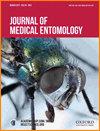更正:阿根廷白纹伊蚊与埃及伊蚊(双翅目:库蚊科)的幼虫竞争:亚洲虎蚊的共存及其分布意义。
IF 2
3区 农林科学
Q1 ENTOMOLOGY
引用次数: 0
摘要
本文章由计算机程序翻译,如有差异,请以英文原文为准。
Correction to: Larval Competition Between Aedes albopictus and Aedes aegypti (Diptera: Culicidae) in Argentina: Coexistence and Implications in the Distribution of the Asian Tiger Mosquito.
Aedes aegypti (Linnaeus) and Aedes albopictus (Skuse) are worldwide vectors of dengue and yellow fever viruses. These species coexist in many countries and the biotic interactions between them can influence their abundances and distributions. In Argentina, Ae. aegypti is widely distributed in the north and center regions of the country, with temperate and subtropical climate, while both are sympatric only in the northeastern area of the subtropical region. Interspecific and intraspecific larval competition for food was evaluated to assess if their interaction influences on patterns of abundance and distribution. Finite rates of increase and survivorship for each species were estimated and the effects of mosquito density ratio and detritus availability were determined. The Lambda ( λ ´) index of population performance of both showed there is no competitive exclusion pattern. However, survival of Ae. albopictus was negatively affected by the presence of Ae. aegypti . These results suggest one possible explanation for the codominance pattern of both species display in rural regions of the southernmost distribution of Ae. albopictus in South America. They also show Ae. aegypti as a potential biotic barrier for the expansion of Ae. albopictus as was reported in regions of the United States.
求助全文
通过发布文献求助,成功后即可免费获取论文全文。
去求助
来源期刊
CiteScore
4.60
自引率
14.30%
发文量
207
审稿时长
3-8 weeks
期刊介绍:
Journal of Medical Entomology is published bimonthly in January, March, May, July, September, and November. The journal publishes reports on all phases of medical entomology and medical acarology, including the systematics and biology of insects, acarines, and other arthropods of public health and veterinary significance. In addition to full-length research articles, the journal publishes Reviews, interpretive articles in a Forum section, Short Communications, and Letters to the Editor.

 求助内容:
求助内容: 应助结果提醒方式:
应助结果提醒方式:


